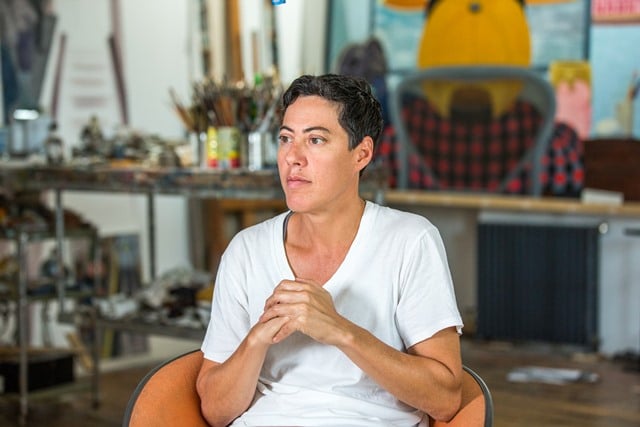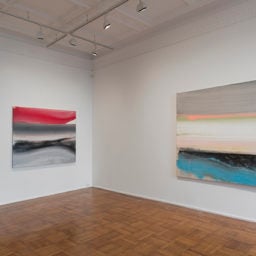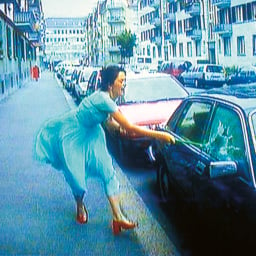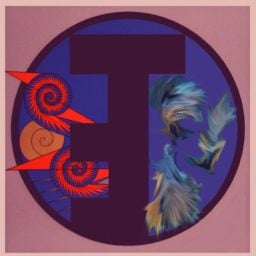Nicole Eisenman—beloved New York painter, now MacArthur-certified “Genius”—has just opened a show at the New Museum with the jokey title, “Al-ugh-ories.”
The single-floor showing of 25 works—22 paintings plus three examples of her recent, scattershot forays into sculpture—is billed as her first monographic museum survey in New York, and it casts an eye specifically to the symbolic-narrative side of her art.
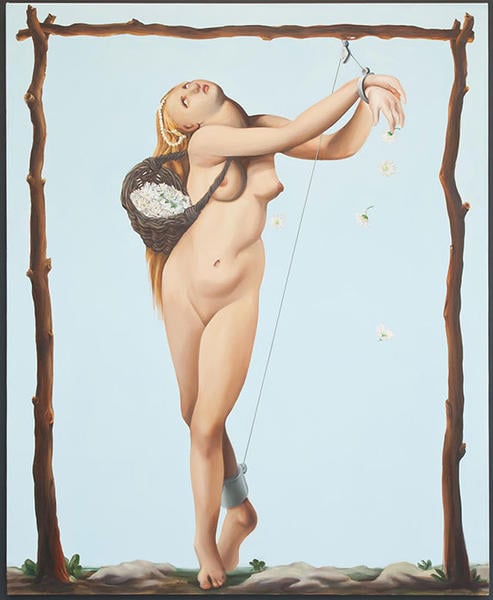
Nicole Eisenman, Spring Fling (1996)
Image: Courtesy New Museum
What, exactly, are these works symbolic of? Speaking with Eisenman in the catalogue, New Museum creative boss Massimiliano Gioni hypothesizes, “your work has become the voice of a queer community.” That’s important for understanding how her paintings have been received and read, but also a reading she bristles against: “I couldn’t claim to draw a line around a group of people and claim to have a voice for anyone but myself.”
Eisenman studied at RISD. In Providence, she had associated with the hardcore punk scene but went wanting for an LGBT scene to connect to, she remembers in the same interview. In 1987, Eisenman moved to New York, discovering here, she says, a “pissed-off mood” that matched her own, as well as the example of big-and-brash 1980s painting.
“[B]y the mid-‘90s, I was in my own romantic bubble,” she continues. “I was separate in some very deep ways from my family and from people in general, but that didn’t preclude me from being critical of this insane culture we’ve created. I was looking two ways at once, intellectually at the world around me and emotional back to my own experience.”
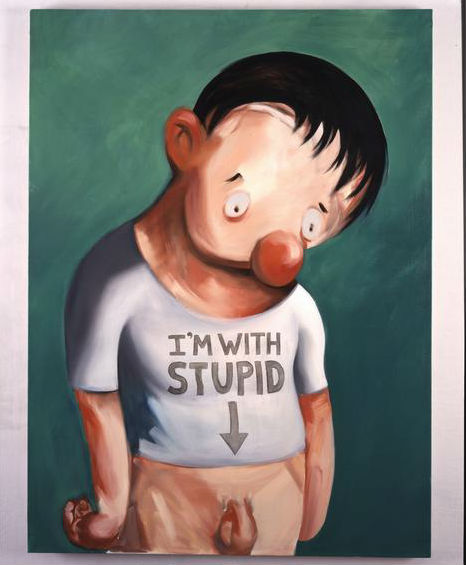
Nicole Eisenman, I’m with Stupid, (2001)
Courtesy of the artist and Susanne Vielmetter Los Angeles Projects
A little later, she adds, “I was painting against my education—against a man-made art world, the one I had learned about, with all its masters… I was just pissed off because I didn’t see a place for myself in that world.”
Ultimately, Eisenman would find art supporters who welcomed her combination of tart humor, psychosexual exploration, and painting-nerd bravado. By 1995, she was showing Self-Portrait With Exploded Whitney in that year’s “back to painting” Biennial, a mural showing her presiding over the wreckage of the museum, an emblem of ambition and humor.
But the sense of separation is key to understanding her “al-ugh-orical” painting.
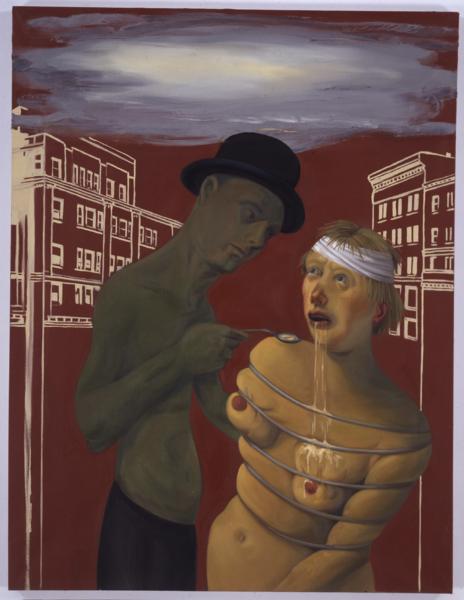
Nicole Eisenman, Commerce Feeds Creativity (2004). Courtesy of the artist and Susanne Vielmetter Los Angeles Projects.
Thus, a canvas like Commerce Feeds Creativity (2004) centers on a leering, bowler-hatted man (“Commerce,” presumably), raising a spoonful of something to the mouth of a bound, bandaged, queasy-looking female nude (“Creativity”). Liquid runs down her face onto her chest. It’s an allegorical rendering of a hostile, patriarchal world, and an art industry steeped in nouveau aristocratic excess. And it’s almost jokingly clear.
But quite often, even in this show dedicated to story and symbol, Eisenman’s universe is much more deeply nested inside that “romantic bubble” she mentioned. Take, for instance, Hamlet (2007), a full-length image of the androgynous Prince of Denmark, isolated onstage, footlights casting dramatic shadows, signature skull in hand.
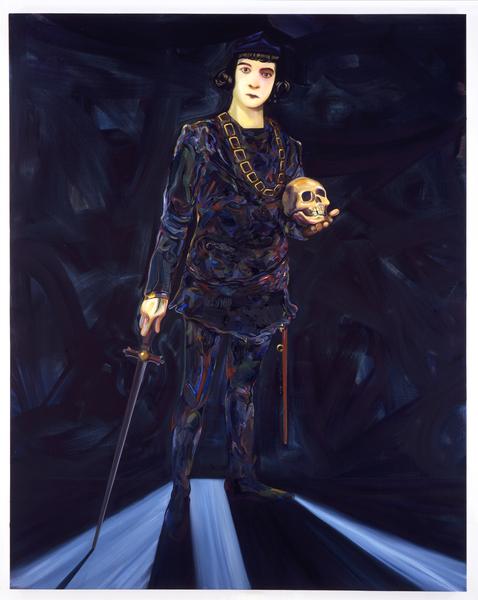
Nicole Eisenman, Hamlet (2007). Courtesy of the New Museum.
The New Museum website explains that in this work, “Eisenman ponders the possibility of a sensitive and cautious leader at a time when the US was in the final year of George W. Bush’s presidency.” Maybe that’s in there, but it would be hard to derive this message; the composition lacks the storybook narrative clarity of Commerce Feeds Creativity.
A lot of the works here fall in between these two poles, as if the symbolic mode was just one style Eisenman played with, much the same way she deliberately mixes textures, or riffs piecemeal on painting styles ranging from Edvard Munch and Philip Guston to colleagues like Amy Sillman.
Yet, there is something that unites these images, symbolically, an element that recurs again and again in this selection of works: the resounding sense of isolation of her figures, which one might relate to a sense of the stigma attached to queerness, or to a more general existential angst, or to some fluid combination of the two.
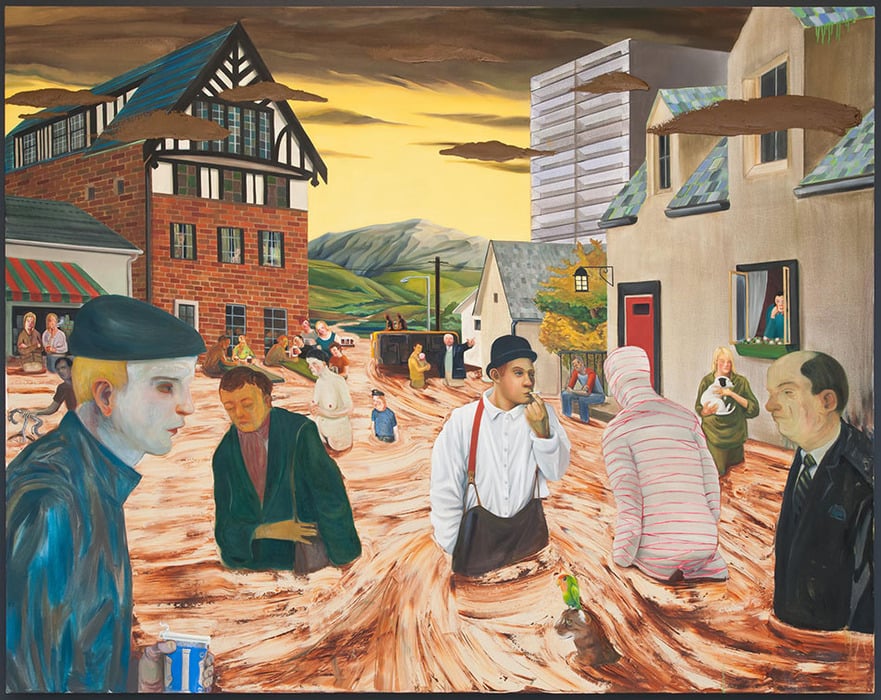
Nicole Eisenman, Copin (2008)
Courtesy of the artist, Susanne Vielmetter Los Angeles Projects, and Galerie Barbara Weiss Photo: © Carnegie Museum of Art
In the large, tellingly titled Coping (2008), an Alpine town seems to have been flooded with brown, encumbering goo. The residents trudge past one another, literally in the shit. The painting is like an anthology of the facial expressions that recur throughout the other works in “Al-ugh-ories,” ranging from blank, to dreamy, to detached, to the (infrequent) pantomime of communication that seems to go nowhere.
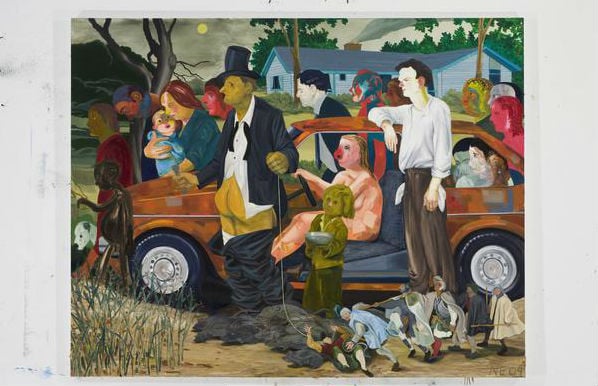
Nicole Eisenman, The Triumph of Poverty
It’s worth noting, here, that Eisenman is a rare painter who can make you laugh out loud as well. Another big canvas, The Triumph of Poverty (2009), features a shambling procession of spectral, bedraggled characters in some kind of forsaken backwoods world. At its center is a man in a top hat, his pants pulled down, his protruding butt thrusting out from where his groin should be—a symbol, the catalogue suggests, of ass-backward leadership.
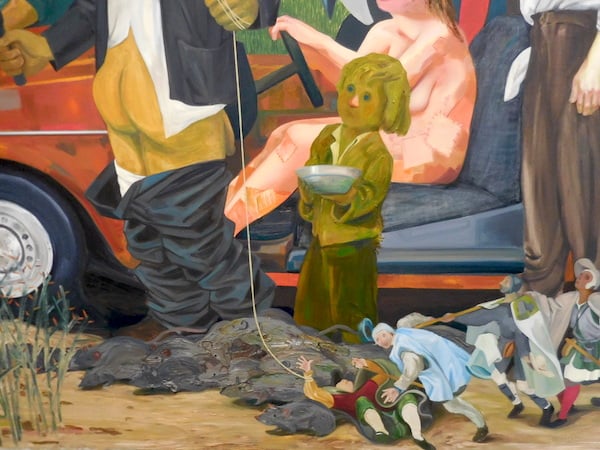
Detail of The Triumph of Poverty. Photo by Ben Davis.
But even that zany touch has a note of dark nihilism in it. Are there hints elsewhere in the show that cut against the overarching sense of alienation between people?
The large canvas Biergarten at Night (2007) swaps Manet’s bustling Music in the Tuileries Gardens (1862) for a hipster beer garden. As you navigate the teeming crowd scene, you discover once again that there are very few gazes that meet, very few open smiles, very few true signs of fellowship. The world that it captures is of a mass of individuals, spatially together but self-absorbed.
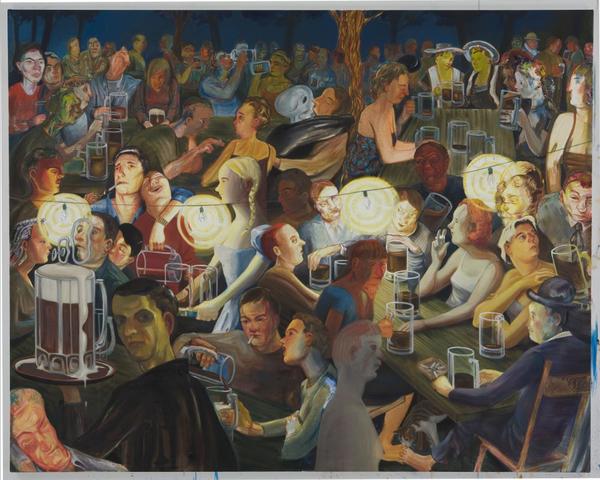
Nicole Eisenman, Biergarten (2007)
Collection Bobbi and
Stephen Rosenthal, Courtesy the artist and Susanne Vielmetter Los Angeles Projects
And then, there it is: In the middle background, at center, an ecstatic kiss. Except it is between a figure (Eisenman likes to play with the gender codes, so I’m not going to guess) and a black-robed skeleton. Her humor shines through: The detail is both glum and self-consciously goofy, as if to dissipate the sense of isolation it implies. But it is still glum.
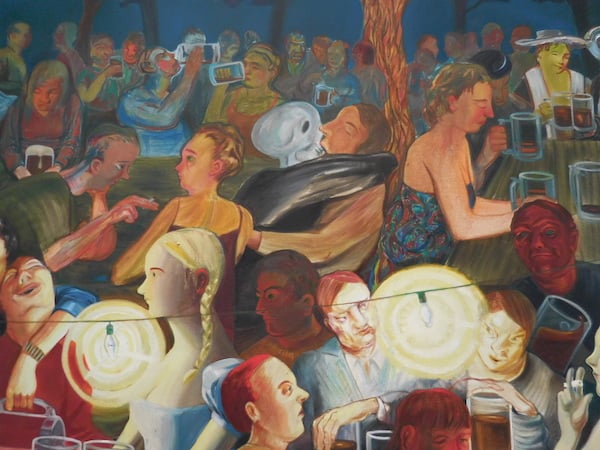
Detail of Biergarten at Night. Photo by Ben Davis.
“It can be a completely liberating and egoless experience to be part of a couple,” Eisenman said in a Bomb interview last year with David Humphrey, “or it can kill you.”
Biergarten at Night renders the lethal side; one of the most recent images in the show, Is it So (2014), brings out the liberating. In this painting—the most memorable single piece at the New Museum—we see only the top of a head; foreshortened, that figure’s parted thighs; and then the peak of a second head, nestled between them.
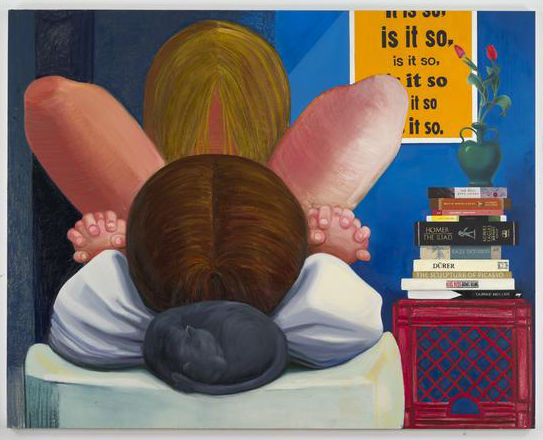
Nicole Eisenman, Is it so (2014)
Courtesy of the artist and Susanne Vielmetter Los Angeles Projects
A cat curls placidly in the foreground, an emblem of contentment. You can’t see the features of either face. They are fused into an almost-abstract, “egoless” mass, except for the passionately interlaced fingers of their hands on either side of the couple.
A stack of books at the right—from The Sculpture of Picasso to a catalogue of Ulrike Müller, another member of the cohort of proudly queer New York artists with which Eisenman has collaborated—indicates that we are likely looking into a painter’s studio.
And so, taken as a whole, this whole show might suggest its own allegorical meaning, turning isolation inside-out: The crowd is no guarantee of companionship, while it is the stereotypically solitary space of art that offers the promise of actual communion.
“Nicole Eisenman: Al-ugh-ories” is on view at the New Museum, through June 26, 2016.
